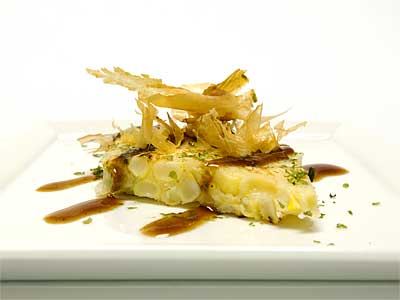June 4, 2012
Amuse-Bouche

beignets de maïs
(corn fritters)
These days, izakaya restaurants are all the rage in Northern California. In Japan, these are drinking establishments that also serve food, generally small plates and often within a single theme, such as yakitori. In California, the food seems to be more important than the drink, which is not always the case in Japan. I’ve only been to a few izakaya restaurants, but I've always enjoyed the experience, at least the part I can remember.
On a recent trip to New York, I made my first visit to Kitchen Arts and Letters. There I found a book by Mark Robinson call Izakaya: The Japanese Pub Cookbook. In the book, I found a recipe for tomorokoshi no kakiage which translates into English as a corn fritter. The recipe looked adaptable as an amuse-bouche.
Little corn fritters were a standard preparation when I use to assist Charlie Vollmar with his cooking classes. The fritters consisted of fresh corn kernels in a batter that were shallow-fried until crisp. The recipe in Izakaya was similar except the shape was more of a ball. Also, the batter called for cake flour instead of the usual all-purpose flour. I was intrigued.
One night, I assembled all the ingredients and started to prepare the fritters according to the recipe, but I was taken over by the spirit of okonomiyaki! I’ve always been told that okonomiyaki is a recent, post World War II, phenomena. Apparently, the history may be longer. It’s antecedents go back a few hundred years. I “discovered” okonomiyaki in 1990 in the town of Kochi.
My wife, son, uncle, and I were traveling around the island of Shikoku, the forth of the four main islands that make up Japan. My uncle was interested in visiting a number of the famous temples on the island. The rest of our motley group was just along for the ride. One particularly hot evening, we took shelter in a department store, and we decided to eat dinner at their restaurant on the second floor. We sat in a small booth where part of the table was actually a flat-top griddle. Our waitress brought various ingredients and preceded to prepare a large pancake filled with some of the ingredients. The remaining ingredients were used to cover the top of the cooked pancake. She used a triangular-shaped spatula to serve each of us a piece of the pancake.
I don’t remember what my impression was of my first okonomiyaki. When we got to Hiroshima, we discovered an okonomiyaki restaurant next to our hotel, so we had the dish there a couple of times. Since then, I have also eaten the dish in Osaka, Tokyo, Toronto, and San Francisco. In each case, it was different. Today, when I have the urge for okonomiyaki, I head to my own kitchen to scratch my itch.
The night that I started to make that tomorokoshi no kakiage, I found myself transforming it into a miniature okonomiyaki. I prepared the original recipe faithfully, but instead of making my fritter three-dimensional, I made it flat like a pancake. The resulting fritter tasted okay, but I wanted more flavor. Much more. After the addition of some okonomi sauce, aonori, and katsuobushi, as I would add to okonomiyaki, I had a winner.
kernels from 1, 18-cm (7-in) long ear
sweet corn
1 medium
hot red pepper, center portion cut into 1-mm (1⁄25-in) wide strips with no seeds
1 medium
hot green pepper, center portion cut into 1-mm (1⁄25-in) wide strips with no seeds
Otafuku-brand Okonomi Sauce
aonori
katsuobushi
batter:
120 ml (1⁄2 c)
filtered water
1⁄2 extra-large
egg yolk
63 g (1⁄2 c)
cake flour
large pinch
fine salt
1. Beat the batter ingredients together. Set aside for a few minutes to hydrate the flour.
2. Heat a small, nonstick frying pan over medium-high heat. If not using nonstick, lubricate the surface with a little neutral vegetable oil.
3. Place the corn and peppers in a bowl, and add enough batter to make everything stick together. There should be some batter left over. Using a large spoon, transfer the vegetables to the frying pan so a single, large pancake, one corn-kernel thick, is created. Use the back of your spoon to even out the fritter. If the batter seems a bit thin around the edge, fill it in with the leftover batter.
4. When the fritter is brown on the first side, flip it over and cook the second side. When the second side is cooked, transfer the fritter to your cutting board.
5. Cut 4 diamond shapes, about 5 cm (2 in) on each edge, from the fritter. There will be lots of scrap for snacking. Place a diamond on each serving dish, and sprinkle a little okonomi sauce, aonori, and katsuobushi over each. Serve while the katsuobushi is still moving!
Yield: 4 servings.
© 2012 Peter Hertzmann. All rights reserved.
